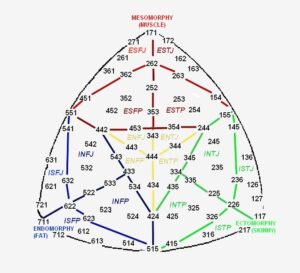The very first thing I have written in my notes for Nonverbal Communication:
What are you saying and do you mean to say it?
Nevertheless, I have found our study of somatotypes slightly disturbing . The idea that people would draw conclusions about our personalities from body-type seems somehow un-American or something.
Somatotyping is the system of body typing and constitutional psychology based on research by William Sheldon in the ’40s. Most of us have heard the terms endomorph, mesomorph, and ectomorph. What troubled me was research showing the following characteristics related to body type:
endomorphy
softer, shorter, old fashioned, warm-hearted, less strong, amiable, talkative, dependent, trustworthy
mesomorphy
stronger, more masculine, better looking, adventurous, younger, more mature, self reliant
ectomorphy
very thin, very tall, very ambitious, suspicious, tense, pessimistic, stubborn
Yikes! How many of us would fit these descriptions? And do we tend to get grumpy and difficult when people assume things about us that are not true?
But look at this chart I found at mySomatotype.com, overlaying somatotype with myers-briggs personality type.
 At first glance, this fits at least myself and the hero fairly precisely. How about you?
At first glance, this fits at least myself and the hero fairly precisely. How about you?

From the WIkipedia entry on somatotype, which I think is rather kind and restrained:
“Sheldon himself was more a behavioral psychologist than either an anatomist or a physiologist. His behavioral conclusions were based largely on interviews which he or his students carried out over a long span of time, and the actual psychometric data was often more suggestive than conclusive. The prevalence of kindred ideas in folklore and spiritual philosophy, though, suggests that ideas similar to Sheldon’s will continue to be held until they are conclusively proven or disproven.”
Ask to see the hard data, not interviews..
I have a lot more time for the MBTI, which is based on Jungian psychology… but still many psychologists are not satisfied with the validity and reliability of the instrument.
When Wikipedia says Sheldon’s “conclusions were based largely on interview which he or his students carried out over a long span of time, and the actual psychometric data was often more suggestive than conclusive” you may be led to believe that these interviews were less reliable than some kind of paper and pencil test. Each interview averaged about twenty hours over a period of months so they were not casual by any means.
When it comes to clothes and personality type I prefer Max Luchers discussion in his book Personality Signs (Warner Paperback 1981) Chapter 3 describes:
Blue Type (Feeling) Traditional
Red Type (Sensation) Unique
Green Type (Thinking) Classic
Yellow Type (Intuition) Fashionable
This is just a brief outline. He elaborates on each of these.
That is very helpful, John. Thank you. I don’t have that book, I think I shall have to get it. 🙂
Yes, WIkipedia can supply an opinion or conclusion with which others do not agree. The interview format is still not adequate rigour for me, though.